As you walk around the gardens at Kijongo Bay Resort, you may be fortunate enough to see some strange nests amongst the leaves, these nests are made by weaver ants. We were quite intrigued by these nests, and so did some research and found them to be very interesting, and thought we would share this info with you.
Chambered Nautilus (Nautilus pompilius)
We had an unusual find on Sange Beach, as we found not one, but 2 chambered nautilus shells, over the past 18 months. Unusual enough that when asked, the local fishermen, had no idea on what they were and had never seen one before. This caused quite a stir among the local fisherman, as to what this strange shell was, and intrigue for us, so we looked for more information about them.
Did you know that a nautilus is an ancient relation to an octopus? As creatures go, the chambered nautilus is one of the most bizarre. It is as if evolution had a sense of humour over time.
Long before dinosaurs were walking on earth, an ancestor of the nautilus was swimming in the ocean, called an Ammonite, over 500 million years ago. Nautilus fossils have been dated to more than 200 million years old.
Why is a nautilus a strange find on the beach in front of Kijongo Bay Resort?
To start with, they are very rare in the Indian Ocean, even more so along the coast of East Africa, with them mostly being found in the deep waters of the Indo-Pacific regions around southern Asia and Australia.
Secondly, they are a deep-water pelagic species, spending daylight hours at depths between 700 to 800 m, and migrating nightly to around 100 m, to forage.
One theory is that the shells found along the East African coast are those of a dead nautilus, that could have spent months or years floating across the ocean from Asia or Australia, before being washed up on Sange Beach.
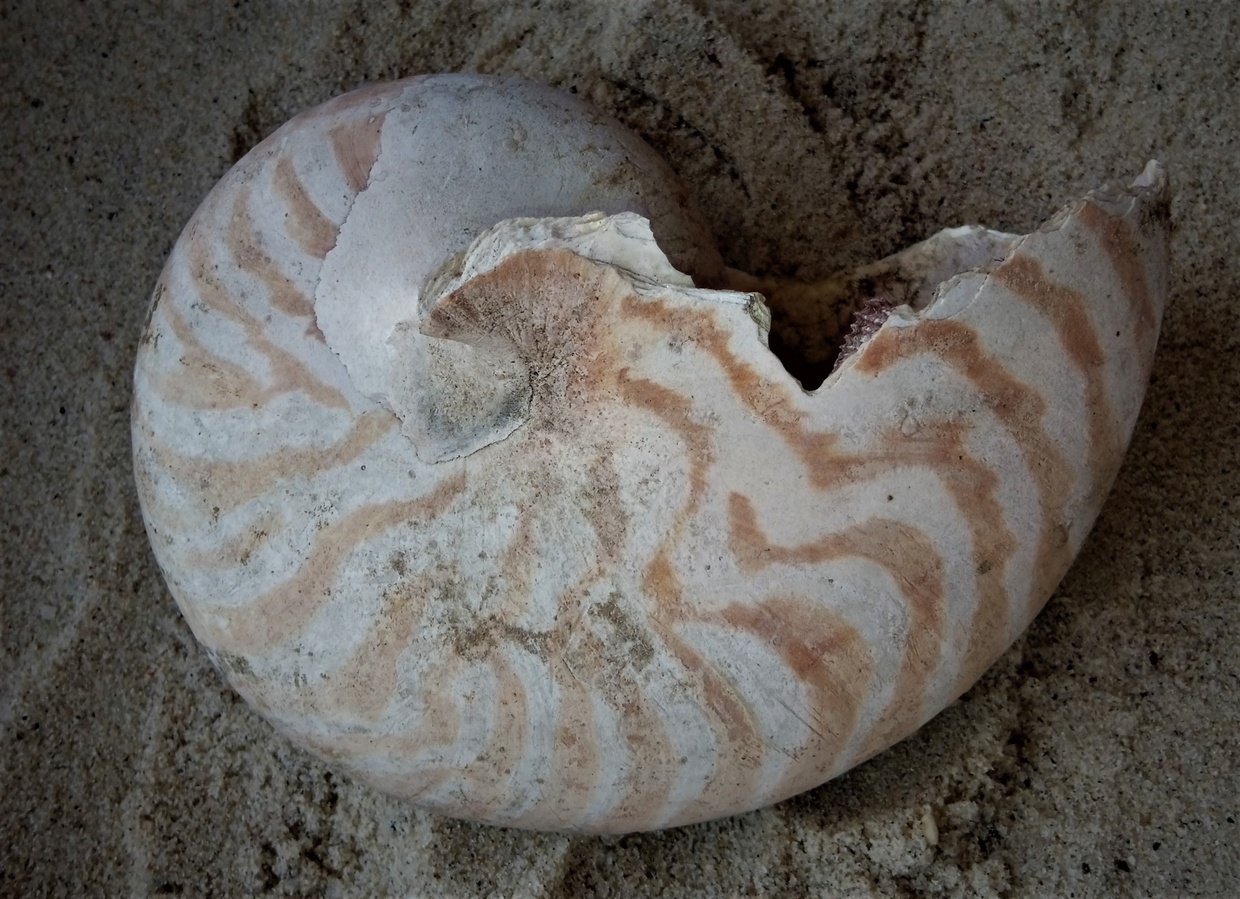
So, what is a nautilus?
It is an invertebrate, meaning it does not have a spine. It is a mollusc, which is a phylum of invertebrate animals, almost all molluscs are gastropods, like snails and slugs. Mollusc basically means soft.
The nautilus is a cephalopod, meaning it is in the class of molluscs containing octopuses, squids, and cuttlefish. The word cephalopod is old Greek and translates to “head-foot”, this could be due to a prominent head and tentacles. So basically, a nautilus is a cephalopod with a shell, looking totally different from all the other cephalopods.
A nautilus shell is made up of chambers, and the animal inhabits the outer, last chamber or opening. The shell is up to 25 cm in diameter. From this opening protrudes the head, 90 tentacles, eyes and the siphuncle of the nautilus.
Unlike its cephalopod family members, the nautilus has between 80 and 90 arms, whereas an octopus has 8, and squid & cuttlefish have 10 arms.
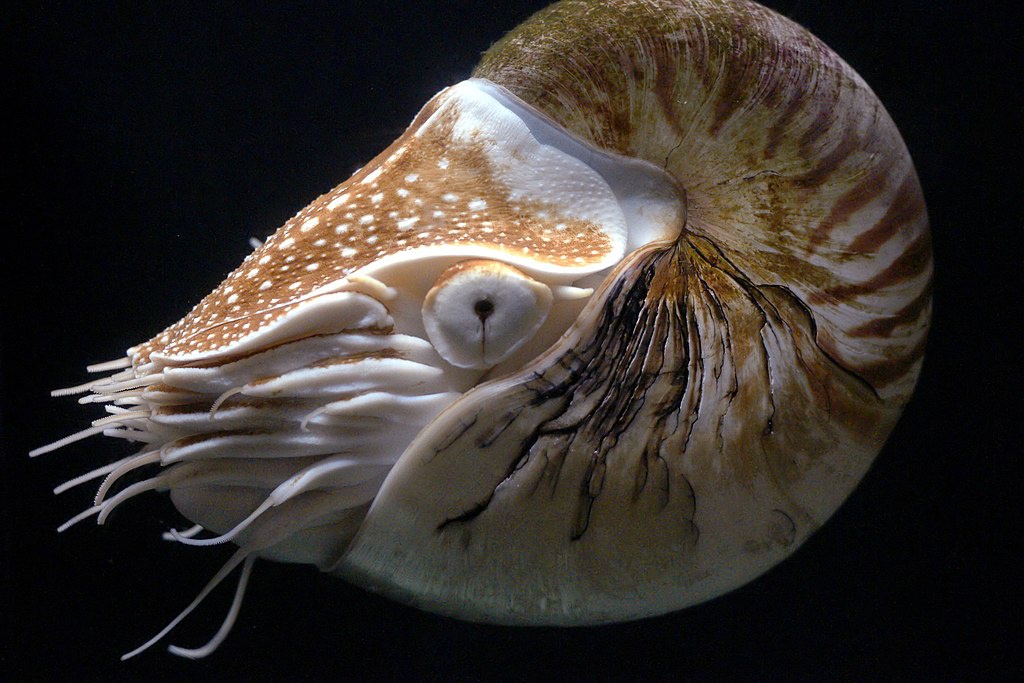 By © Hans Hillewaert, CC BY-SA 4.0, https://commons.wikimedia.org/w/index.php?curid=4657561
By © Hans Hillewaert, CC BY-SA 4.0, https://commons.wikimedia.org/w/index.php?curid=4657561
The nautilus shell has camouflage markings of dark brown to purple stripes, with the underside being counter shaded. No two nautilus shell markings are the same, with each shell having individual stripes, a lot like zebras.
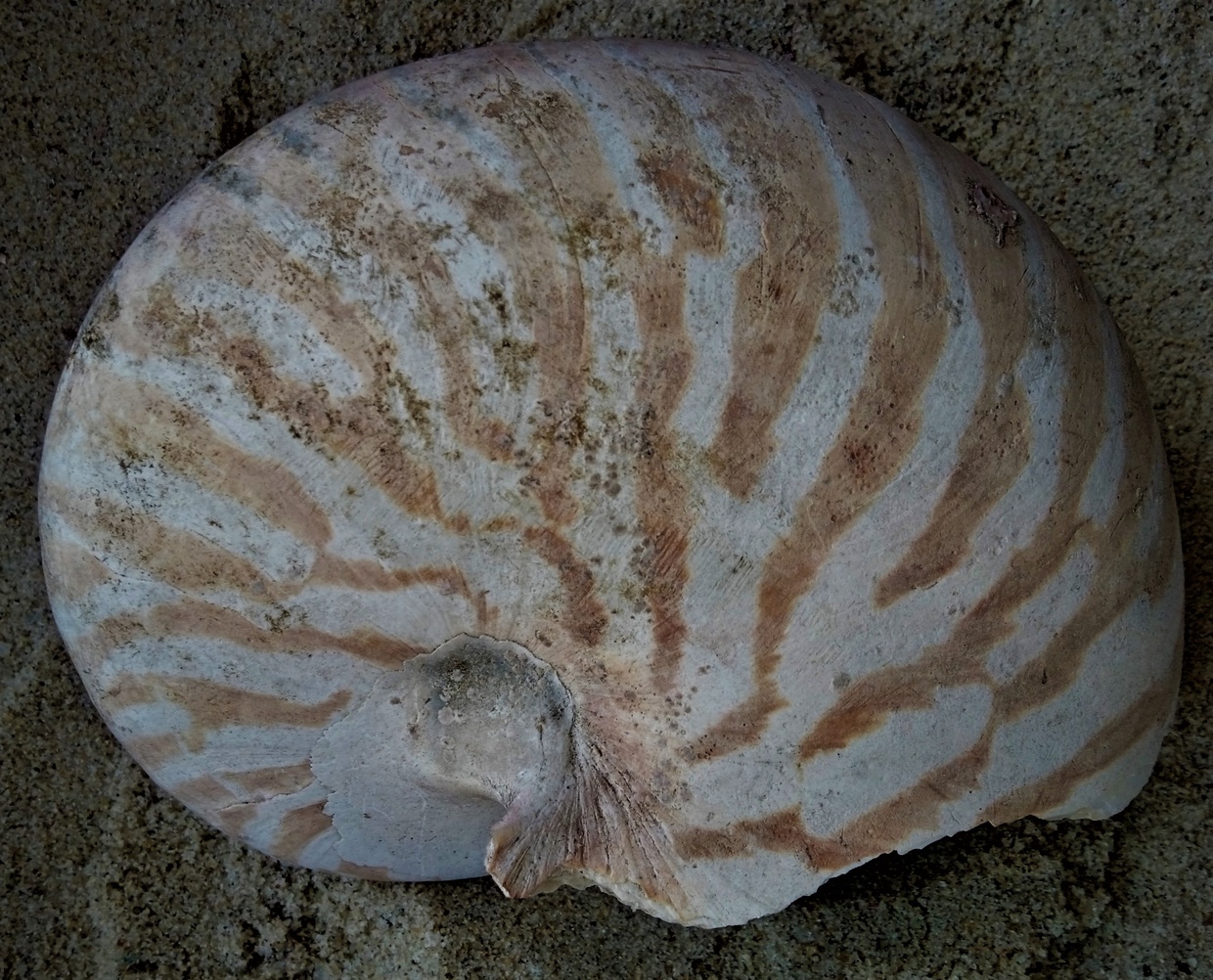
The nautilus controls its buoyancy using its siphuncle, by filling and emptying the chambers in its shell with water. The chambers contain a mixture of liquid saline solution with a nitrogen/argon solution. By adding or removing the amount of water in the chambers, the nautilus can change their depth.
The shell is made of calcium carbonate. The nautilus uses its shell for protection, being able to withdraw into its shell and block the opening almost totally with its legs, to act as a reinforcement.
A nautilus uses “jet propulsion” to move through the water by expelling water under pressure through a siphon located in the mantle cavity, next to its head. This allows the nautilus to move forwards, backwards and sideways.
The nautilus has two large eyes, but very poor vision, basically they have primitive pinhole eyes. The nautilus can only detect light and dark.
The nautilus uses its sense of smell to detect food. Being mostly a scavenger, feeding on dead fish and the remains of other species' meals. They are also opportunistic hunters, catching shrimps, swimming crabs, hermit crabs and small fish. Nautilus have been observed digging in sediment looking for food. They also show cannibalistic tendencies, by catching and devouring other nautiluses. A nautilus has a parrot like beak, similar to an octopus, that it uses to remove small pieces of its prey, this is then shred further by its radula to feed.
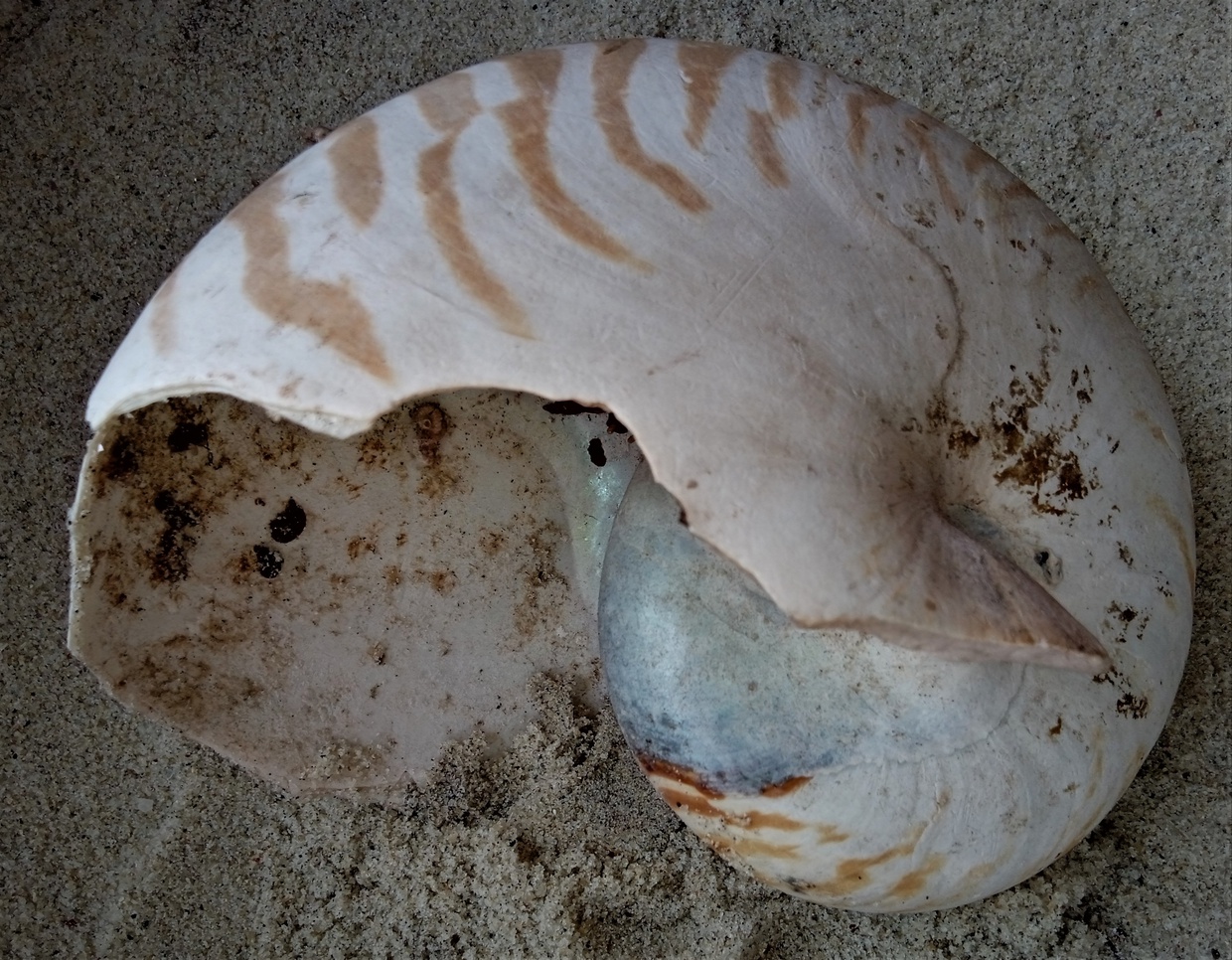
Fibonacci sequence? Maybe or maybe not!
When the nautilus hatches, the shell has 4 chambers, on reaching adulthood, it has 30 chambers. Through its life, it has a constant growth rate of spirals to its shell, at a ratio of 1.08.
This 1.08 is a pattern that repeats in every 24 numbers in the Fibonacci sequence. This makes the nautilus shell one of the best logarithmic spirals in the animal kingdom.
The shell is often used as an example of the golden spiral, even though the ratios averages are not quite there.
The nautilus shell displays one of the closest natural equiangular spirals in the animal kingdom.
Nautilus status and future
Unfortunately, the shell of the nautilus is a rare beauty, leading to this cephalopod becoming endangered by overfishing. The shells are primarily used for ornamental artifacts and jewellery. Nautilus are now CITES Appendix II. (CITES - Convention on International Trade in Endangered Species of Wild Fauna and Flora).
As the nautilus shell is listed as CITES Appendix II, it means that it cannot be exported or imported without a permit.
Some of the shells you find on the beach in front of Kijongo Bay Resort have the same protection from CITES.
Unless you know 100% the species and protection status of the shells, it is recommended that you do not try and take any shells through the airport. If caught with a protected species, the fines can be substantial.
What is the Fibonacci Sequence?
The Fibonacci numbers first came to life in Indian mathematics, in a paper by Pingala in 200 BC, while describing patterns in Sanskrit poetry. The sequence was introduced into European mathematics in 1202 in a book by Leonardo of Pisa, known as Fibonacci, called Liber Abaci.
The Fibonacci sequence is a recursive sequence that is generated by adding the two previous numbers in the sequence, starting with 0 to infinity. The Fibonacci sequence and the golden ratio are interconnected.
The Fibonacci sequence in numbers.
0,1,1,2,3,5,8,13,21,34,55,89,144,233,377,610,987, 1597, 2584 ……………………………..
The Fibonacci sequence in a graph form

Fibonacci numbers appear in both modern applications and in nature. The sequence appears in computer algorithms, programs and search techniques. In nature, it appears in many different settings. From things we can see, right down to the microscopic structure of some cancer cells and the formation of some fish embryos.
Visually in nature we see the Fibonacci sequence in the spiral shape of galaxies, The shape of hurricanes, the shape of a chicken egg, the spiral of a chili pepper, sunflower flowers, some daisy flowers, a pine cone bracts, artichoke flowers, The fruit sprouts of pineapples, the curled tail of a chameleon tail, a curled up millipede, snail shells, finger prints, fossils of shells and the list is almost endless.
There are some great videos on youtube.com that explain and show examples of the Fibonacci sequence.
Some photographers apply the Fibonacci sequence in their quest for the perfect photograph, but that is a completely different blog.
Further Reading
Beachcombing in front of Kijongo Bay Resort, you never know what you might find. We came across quite a few brightly coloured starfish, and wanted to know more about these strange creatures, which we thought we would share with you.
Pollen is how plants reproduce, as pollinators move from flower to flower, they deposit the collected pollen from flower to flower, basically allowing the plants to mate.

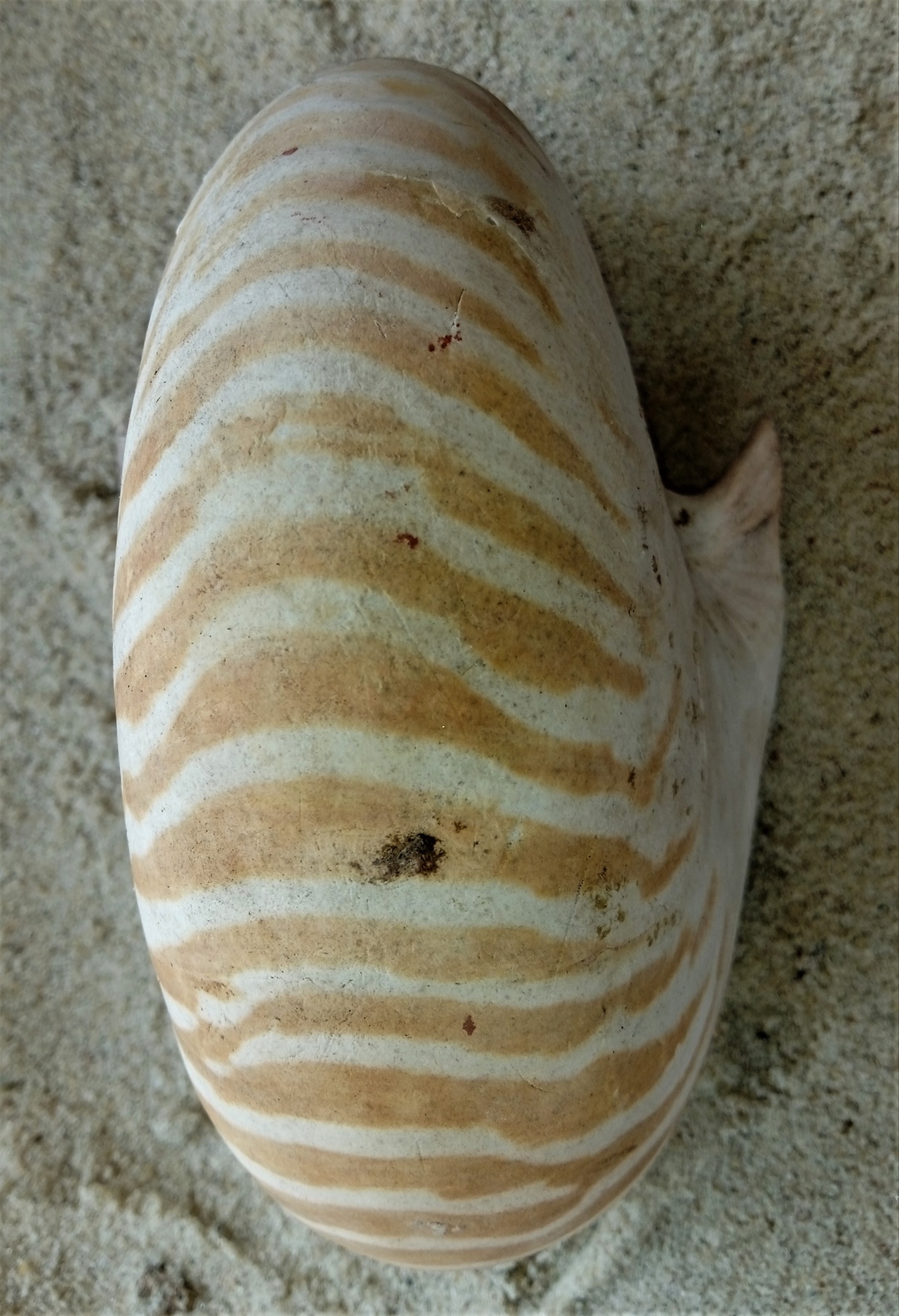






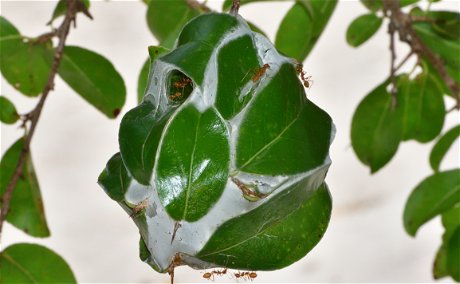

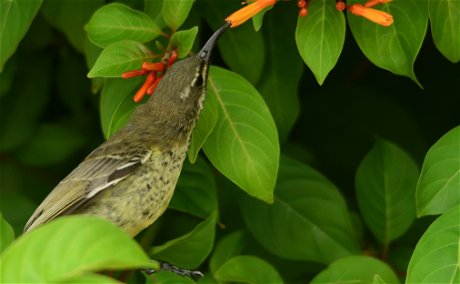
Share This Post